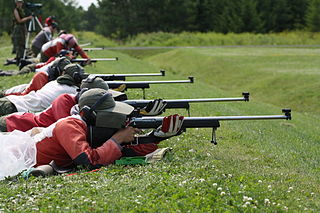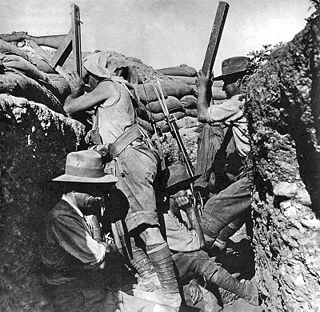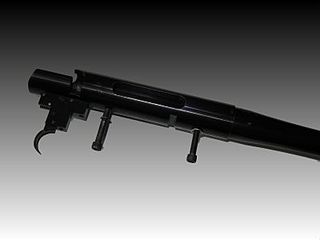Related Research Articles

Bolt-action is a type of manual firearm action that is operated by directly manipulating the bolt via a bolt handle, which is most commonly placed on the right-hand side of the firearm.

In firearms terminology, an action is the functional mechanism of a breech-loading firearm that handles the ammunition cartridges, or the method by which that mechanism works. Actions are technically not present on muzzleloaders, as all those are single-shot firearms with a closed off breech with the powder and projectile manually loaded from the muzzle. Instead, the muzzleloader ignition mechanism is referred to as the lock.

The Lee–Enfield or Enfield is a bolt-action, magazine-fed repeating rifle that served as the main firearm of the military forces of the British Empire and Commonwealth during the first half of the 20th century, and was the British Army's standard rifle from its official adoption in 1895 until 1957. The WWI versions are often referred to as the SMLE, which is short for the common "Short, Magazine, Lee–Enfield" variant.

The Martini–Henry is a breech-loading single-shot rifle with a lever action that was used by the British Army. It first entered service in 1871, eventually replacing the Snider–Enfield, a muzzle-loader converted to the cartridge system. Martini–Henry variants were used throughout the British Empire for 47 years. It combined the dropping-block action first developed by Henry O. Peabody and improved by the Swiss designer Friedrich von Martini, combined with the polygonal rifling designed by Scotsman Alexander Henry.

The .303 British or 7.7×56mmR, is a .303-inch (7.7 mm) calibre rimmed rifle cartridge. The .303 inch bore diameter is measured between rifling lands as is the common practice in Europe which follows the traditional black powder convention.
The Winchester Repeating Arms Company was a prominent American manufacturer of repeating firearms and ammunition. The firm was established in 1866 by Oliver Winchester and was located in New Haven, Connecticut. The firm went into receivership in 1931 and was bought by the Western Cartridge Company, a forerunner of the Olin Corporation. The Winchester brand name is still owned by the Olin Corporation, which makes ammunition under that name. The Winchester name is also used under license for firearms produced by two subsidiaries of the Herstal Group – FN Herstal of Belgium and the Browning Arms Company of Ogden, Utah.

The Rifle, .303 Pattern 1914 was a British service rifle of the First World War period, principally manufactured under contract by companies in the United States. It was a bolt-action weapon with an integral 5-round magazine. It served as a sniper rifle and as second-line and reserve issue, until declared obsolete in 1947. The Pattern 1914 Enfield was the successor to the Pattern 1913 Enfield experimental rifle and the predecessor of the U.S. Rifle M1917 Enfield.

Fullbore Target Rifle (TR) is a precision rifle shooting sport discipline governed by the International Confederation of Fullbore Rifle Associations (ICFRA). The sport evolved as a distinct British and Commonwealth of Nations discipline from Service rifle (SR) shooting in the late 1960s. Its development was heavily influenced by the British National Rifle Association (NRA). Due to this history, it is usually contested amongst the shooting events at the Commonwealth Games, although not at the Olympics. World Championships are held on a four-year cycle. The annual NRA Imperial Meeting at Bisley in the UK is globally recognised as a historic annual meeting for the discipline.

The origins of the modern British military rifle are within its predecessor the Brown Bess musket. While a musket was largely inaccurate over 100 yards (91 m), due to a lack of rifling and a generous tolerance to allow for muzzle-loading, it was cheap to produce and could be loaded quickly. The use of volley or mass firing by troops meant that the rate of fire took precedence over accuracy.

A periscope rifle is a rifle that has been adapted to enable it to be sighted by the use of a periscope. This enables the shooter to remain concealed below cover. The device was independently invented by a number of individuals in response to the trench warfare conditions of the First World War, and while it is not clear which army was the first to use periscope rifles, the weapons were in use by the end of 1914.

Stevens Arms was an American firearms manufacturer founded by Joshua Stevens in 1864 in Chicopee, Massachusetts. The company introduced the .22 Long Rifle round and made a number of rifle, shotgun, and target pistol designs. By 1902, they were advertising themselves as "the largest producers of sporting arms in the world". They were purchased by New England Westinghouse on May 28, 1915, and again by Savage Arms on April 1, 1920. As a division of Savage, Stevens continued to produce firearms at their Chicopee Falls facility until 1960 when the plant was torn down and Stevens production was moved into other Savage facilities. Savage dropped the Stevens name in 1991, but revived it in 1999 and still uses it today for a number of its low cost rifles and shotguns.

The Charlton automatic rifle was a fully automatic conversion of the Lee–Enfield rifle, designed by New Zealander Philip Charlton in 1941 to act as a substitute for the Bren and Lewis gun light machine guns which were in severely short supply at the time.
Sportco was an Australian manufacturer of rifles and shotguns in Adelaide, South Australia, from 1947 until the early 1980s. Founded by Jack Warne, also known by its full name Sporting Arms Limited, began by manufacturing single shot 22LR rifles. Sportco purchased ex military Martini Cadet rifles from the Australian Government and converted them to both rimfire and centrefire calibres as well as rebarrelling Lee–Enfield rifles to .303/22 and .303/25.
The Lithgow Small Arms Factory, or Lithgow Arms, is an Australian small arms manufacturing factory located in the town of Lithgow, New South Wales. It was created by the Australian Government in 1912 to ease reliance on the British for the supply of defence materials.
The Martini Cadet is a centrefire single-shot cadet rifle produced in the United Kingdom by BSA and W.W. Greener for the use of Australian military Cadets. Although considered a miniature version of the Martini–Henry, the internal mechanism was redesigned by Auguste Francotte to permit removal from the receiver as a single unit. Chambered for the .310 Cadet cartridge, it was used from 1891 to 1955. They were also sold to the public thereafter, as the BSA No.4, 4a, 4b and 5 in other calibres like the .297/230 and .22 rimfire. The rifles will often chamber the similarly sized .32-20 Winchester and fire with some accuracy. However the 32/20 is actually 0.312 cal and the 310 is 0.323 cal. Due to this 10 thousandths difference the accuracy of a .32/20 round cannot be guaranteed.

The .303/25, sometimes known as the .25/303 is a wildcat centrefire rifle cartridge, based on the .303 British, necked down to fire a .257 projectile, originating in Australia in the 1940s as a cartridge for sporterised rifles, particularly on the Lee–Enfield action; similar versions also appeared in Canada around the same time.
During the American Civil War, an assortment of small arms found their way onto the battlefield. Though the muzzleloader percussion cap rifled musket was the most numerous weapon, being standard issue for the Union and Confederate armies, many other firearms, ranging from the single-shot breech-loading Sharps and Burnside rifles to the Spencer and the Henry rifles - two of the world's first repeating rifles - were issued by the hundreds of thousands, mostly by the Union. The Civil War brought many advances in firearms technology, most notably the widespread use of rifled barrels.

The Angel M80 Rifle is a 7.62×51mm single shot target rifle designed and made in New South Wales in Australia by Bill Angel in the 1980s. The Angel action was one of the first solid cylindrical type target actions made in that country. It followed the success of the Swing design in the UK which saw the move away from 'open' designs; often derived from 19th Century military actions. It was approved for use in Australia on 1 November 1980.
The Swing rifle was a design developed by a number of target shooting enthusiasts who came together in 1970 at Bisley. The design's primary instigators were George Swenson and Laurie Ingram. At the time target rifle competition in the UK was dominated by designs based on military actions such as those of the Lee–Enfield and Mauser 1898. These designs were felt to have reached the limits of their development potential; especially when combined with commercially manufactured or hand-loaded ammunition.

A cadet rifle is a rifle used by military cadets and others for basic firearms and marksmanship training. Generally .22 caliber and bolt-action, they also come in semi-automatic versions. They are often miniature .22 caliber versions of standard issue service rifles.
References
- ↑ Custom Barrel Profile. "TSE". Tsengineering.com.au. Archived from the original on 2012-02-13. Retrieved 2014-01-18.
- ↑ "Sportco". Archived from the original on 2014-02-13. Retrieved 2014-01-18.
- ↑ Guns Australia December 2007 p.49
- ↑ AWM [ dead link ]
- ↑ Total Solutions Engineering Archived July 19, 2008, at the Wayback Machine
- ↑ "MAB". Archived from the original on 2008-07-19. Retrieved 2008-06-01.